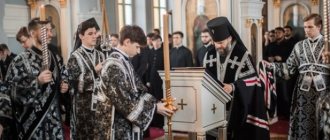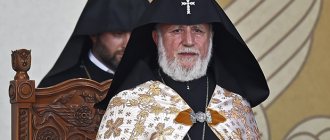Legally, the church is separated from the state and lives according to its own laws, not regulated from outside. But this is a theory. In practice, the institution of the church, although very closed to outside views, is closely integrated into the life of modern Russian society. In one form or another, church ministers receive a salary for their activities. And if this is so, then the question of how much priests earn is also quite legitimate. Let's figure it out.
What is the income of the Russian Orthodox Church
The Russian Orthodox Church is essentially a giant corporation with an extensive network of regional offices in all corners, even the most remote from the center. A very rich and extremely influential corporation. A corporation that has significant tax benefits and uses this to generate enormous income. But since the institution of the church, as we have already mentioned, is very closed, it is not possible for the general public to obtain reports on the items of the church’s income and expenses.
We only have indirect indicators. Several years ago, information was publicly available that the church’s annual income from donations, various ceremonies, and the sale of various printed materials amounted to 5.6 billion rubles. Let us remember that this income is not subject to income tax. Since then, this figure has clearly only grown.
In addition, the church regularly receives targeted financial support from the state aimed at the implementation of specific cultural programs, various projects, the functioning of funds and restoration activities.
No taxes
We have already mentioned that the church is not considered a commercial organization, and therefore does not pay taxes on activities that are considered religious41. This helps to increase income, create corruption schemes, and in some cases also minimize costs, as in the scandalous incident with benefits for the import of tobacco and alcohol4243, which was successfully carried out “for the needs of the Russian Orthodox Church.”
Spiritual education
What does it take to become a priest? First you need to receive higher spiritual education. Educational institutions training priests are:
- Orthodox University;
- theological Seminary;
- Theological Academy.
The training lasts a standard five years. The most prestigious educational institutions in the industry are the Russian Orthodox University, the Trinity-Sergius Academy and the Theological Academy in St. Petersburg.
To become a clergyman, you must meet the following requirements:
- believe;
- graduate from a theological seminary or academy;
- have a recommendation from a current priest;
- be over 30 years old;
- be a regular parishioner of the church;
- know the basic spiritual scriptures, creations and deeds;
- reach the age of thirty;
- get married, and only once;
- know the Church Slavonic language;
- Constantly monitor the neatness of your appearance.
Historically, in Russia, priests often perform the work of a psychologist. It is not without reason that psychology is one of the disciplines that, along with specialized subjects, is consistently and thoroughly studied in religious educational institutions. The priest listens to the person, delves into his problem and advises a solution based on his understanding of the situation and guided by the traditions of the Orthodox faith.
To make a career in the church line, it is very important to be sociable, to be able to build relationships with superiors and to be ready to go through all career steps. As practice shows, the best careers in the structure of the Russian Orthodox Church are made by people who are assertive and loyal to management. These people are promoted and even given the opportunity to jump over some career steps.
Laundering of money
Priests are talkative, but not clean at hand
Russian proverb
Since the Church is a non-profit institution, exempt from paying taxes, it turns into a kind of offshore zone. The church can also act as an intermediary in corrupt deals. This is done like this: the criminal donates money for a new temple, and then the clergyman, for part of this money, does with the whole amount the actions that are required of him. It is simply impossible to prove that this is criminal money. According to Vesti of Ukraine, more and more religious organizations are offering this type of service31. Also, for example, the Regnum news agency received a letter from Evgeny Smirnov, the guard of the St. Nicholas Church in Yakutsk, who asked to check the diocese for money laundering32.
By the way, this is one of the main reasons for the love of the modern Russian authorities for the Church: the nomenklatura is financially interested in the Russian Orthodox Church. And therefore she benefits from the opacity of the Church.
In addition, through cooperation with the Church, it turns out that the corrupt official is performing a charitable deed, which is an advantage compared to other methods of money laundering. Another advantage of this scheme is the opportunity to make the necessary connections, since many security forces, crime bosses and officials choose spiritual mentors who allow them to communicate with representatives of such circles. I think this is precisely the reason for the baptism of such people as, for example, Boris Berezovsky.
The Russian Orthodox Church is good at hiding this part of its activities, but some religious organizations do not even try to hide it (screenshot from vedavat.com.ua)
The nature of the clergy's income
The priest's income is formed in a unique way. Orthodox clergy receive a certain percentage of the income received by the church in which they serve. The nature of income, as we have already found out, can be different:
- sponsorship fees;
- voluntary donations from parishioners;
- income received by the church from the sale of various products (mainly candles, icons and printed materials)
- money collected for services rendered and other commercial activities;
Each church shop brings constant and unrelenting income to its parish. Of the total income, the rector sends 20% to the diocese, and the rest of the money is spent on paying for utilities and forming a wage fund.
Initially, the salary of a priest is correlated with the average salary of social workers in a given region. But this guideline is conditional.
Other goods
Church shops have gone far beyond the traditional church assortment - they offer not only the usual “products”, but also a wide selection of audio and video cassettes with Orthodox themes, special clothing (from scarves and skirts for women to baptismal sets for babies), food (honey , Cahors, nutritional supplements, herbs), pottery and souvenirs, pilgrimage vouchers, small goods like leather wallets or T-shirts with Orthodox prints, and so on.
Widespread commercial use of icons - there can be options for any budget, from very cheap to very expensive icons on wood, using expensive paints and with gold frames decorated with precious stones and enamel.
Also in the second half of the 1990s, there was an increase in the production of food products (bread, water, honey, herbs, cheese, wine, tea) under the “church” brand. In almost every region you can find “church” or “monastery” water and honey on the shelves of grocery stores, and in large cities - church bakeries.
Rituals and sacraments performed by Orthodox priests
Baptism
The sacrament of baptism is the very first church rite in a person’s life. Baptism can be performed at any age. But the Russian Orthodox Church more welcomes the baptism of a child in infancy. During the ritual, the baby is immersed in water three times. Older people are simply sprinkled with holy water. Godparents must participate in the ritual - people chosen by the parents who undertake to assist in raising the child and introducing him to the faith.
Confirmation
This ritual is performed after baptism. It can only be performed by an Orthodox priest. This process involves anointing a person's ears, eyes, nose, hands and feet with holy oil. It is believed that only after this procedure does he fully join the Orthodox Church. Confirmation is also performed for those of other faiths who convert to Orthodoxy.
Confession
Repentance, or the sacrament of confession, usually precedes communion. Confession is conducted individually with a priest and is entirely voluntary. Before confession, the priest usually reads a prayer, thereby setting the believer in the appropriate mood. After the prayer, the person expresses what has accumulated in his soul and confesses to the priest the sins he has committed. After the end of the ceremony, the priest covers the head of the believer with an epitrachelion - part of the vestment that the priest wears around his neck. The priest makes the sign of the cross, and the man kisses the Cross and the Gospel. What is revealed to the priest during confession cannot be passed on to third parties.
Participle
Communion is the main rite of worship and is accompanied by a sermon by the priest. During the ceremony, parishioners take bread and wine from the hands of the priest. These products symbolize the body and blood of Jesus Christ. The ritual serves as a reminder of God's self-sacrifice and love for others. According to church dogma, regular communion brings a person closer to the Lord.
Wedding
When a marriage is concluded, a wedding ceremony takes place between believers. According to the canon, during a wedding, the Holy Spirit descends on a couple and strengthens their bonds. The ceremony is held only on Mondays, Wednesdays, Fridays and Sundays. Only married baptized people are allowed to attend the wedding. Men over 70 and women over 60 can no longer get married.
Priesthood
With this sacrament, a person receives holy orders and himself receives the right to conduct Orthodox rites and sacraments. This sacrament is necessarily preceded by the confession of the person receiving the ordination and the sacred oath. After carrying out these actions, the bishop decides whether this Christian is worthy to receive the rank. There are three degrees of priesthood:
- Deacon
- Presbyter or priest
- Bishop or bishop
Unction
This ancient sacrament of the Orthodox Church is designed to heal bodily and mental illnesses. It is in general terms similar to repentance, but unlike it, it frees a person even from sins that he forgot to mention. Since holy oil is used in the rite, its name is triple the consecration of oil. Usually several priests participate in the unction.
Peculiarities
The monastery has a room intended only for sisters. There they communicate alone with God; no outsider enters there.
Each nun wears a habit (monastic dress), and her head is covered with velen (translated from Polish as “veil”). When she sleeps, she takes off her clothes.
Sister Tatiana does not have a cosmetic bag; nuns do not use decorative cosmetics. But things like shampoo, shower gel and cream are a must.
Each sister wears a cross and may wear a rosary (a special form of rosary, which is a ring on a finger) to pray somewhere outside the walls of the monastery (for example, on public transport).
Career
The church hierarchy is not obvious to lay people. In short, there is a division between clergy and clergy. Clergy are the lowest level of the hierarchy; these people can only help conduct services. To become a clergyman you need to be ordained. This procedure makes it possible to perform sacraments and rituals. The clergy are:
- deacons;
- priests (priests);
- bishops;
- bishops;
- archbishops;
- metropolitans;
- patriarch.
A young man who graduates from seminary becomes a subdeacon before being ordained. And only then does he become a deacon. How quickly a person will climb the career ladder depends on the data and abilities of a particular person. Connections are of great importance. The Russian Orthodox Church is a fairly closed system. Usually one becomes a clergyman no earlier than a person turns 21 years old. It is important to find a place for yourself in the temple and to please the abbot, after which there are no special obstacles to initiation.
Bottom line
The same can be said about all religious organizations - the only question is to a greater or lesser extent. There are religions that do not use most of the methods of earning money described in this article and used by the Russian Orthodox Church, but still remain a business - at least as an additional way to earn money. For the Russian Orthodox Church, the localization of Hebrew folklore and its sequels adapted for the local market are mainly a business:
“Every diocesan meeting we have begins with an announcement to the parishes: if you don’t collect the required amount, the rector will be changed. Nobody cares whether a priest fulfills his pastoral duties; what’s more important is whether he can raise money, says a cleric of one of the churches in southern Russia. — We collect up to 8 million rubles a year. donations, we pay 30% to the diocese, but each visit of the bishop is accompanied by an additional collection of money in an envelope”44.
RBC
Given all of the above, progressive social democrats must do everything possible to implement the religious policies that we have described in this article. We hope that it will allow us to transform the Church from a business into a spiritual organization, where only sincere believers will remain.
How much do priests earn?
As we know, the salary of an employee of a commercial company or organization directly depends on his immediate supervisor. There is a similar situation in the church - the amount of remuneration for a priest depends on the favor of the rector of the church towards him.
In Russia, the salaries of clergy vary dramatically. A priest in a small Ural village and a priest in the Cathedral of Christ the Savior receive absolutely money that is even strange to compare.
In rural churches in the Russian outback, a clergyman receives on average about 15 thousand rubles. The average salary of Orthodox priests in our country is approximately 65 thousand rubles.
Ordinary clergy in the capital receive an average income of 100 thousand rubles per month. The rectors of small Moscow churches have an income of at least 300 thousand rubles. In large metropolitan parishes, the income of a rector can exceed a million rubles.
Donations
One of the most obvious sources of income is donations. Most of them are not coins at all, which the congregation throws into a box with the inscription “for repairs of the temple” (or during church services). Cult ministers individually work with very rich and, presumably, very sinful people (leaders of organized crime, corrupt businessmen and officials, law enforcement officers, and so on). Here the prospects are much more significant - news regularly appears like “in the Oryol region a priest was given an SUV for 6 million rubles”4 or even “in Volgograd a pensioner transferred an apartment to a priest after confession”5. Boris Berezovsky admitted in an interview with the Dozhd TV channel that he financed the Orthodox newspaper of Alexei Vishnyak,6 who later accused him of organizing the scandalous action of the Pussy Riot group.
There is also the Russian Club of Orthodox Patrons of the Arts, which positions itself as “an elite club uniting representatives of various business sectors”8. The following sources of funding are indicated on the website of this organization: membership fees; deductions from the businesses of club members; income from business processes organized by the club on the basis of the charter9. The social composition of the Church’s patrons is wide and includes not only entrepreneurs: many bandits and crime bosses are believers, some even have personal priests10.
In iconography there is such a plot - “Unexpected Joy” - depicting a criminal begging the icon for forgiveness. He is very popular among “thieves in law” and “brothers” from the 90s
However, not all the money collected for the construction or repair of churches goes to these purposes. The most famous story is the construction of a temple on the site of the murder of Nicholas II and his family, when emeralds alone were stolen for 165 million rubles (29 kilograms)11.
Vacation and pension
All priests have standard work books and the rector of their parish makes the necessary contributions to the pension fund. In theory, each of them can retire when they reach 65 years of age.
But in reality, priests, as a rule, do not retire and continue to work as long as their health allows them. A priest who retired at 65 is an atypical and extremely rare case. The standard vacation for clergy is 28 days. Everyone conducts it as they see fit.
Work specifics
Clerics have a full-time job; they usually serve 12-14 hours every day. They don't have days off. Each parish has its own daily routine, but in general it is similar in all churches:
- 08:00 – 10:50 — confession, liturgy;
- 11:00 – service of prayers, memorial service for the departed;
- 12:00 - 14:00 - performance of the Sacraments;
- 15:00 - 16:45 – conversations with parishioners;
- 17:00 – evening worship.
In addition to serving in the church, the cleric travels to perform services at home, in the hospital, in orphanages, and boarding schools for the elderly, so his work schedule is irregular.










